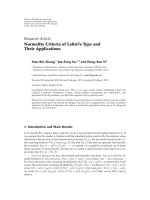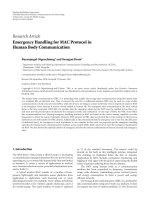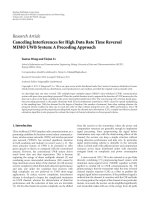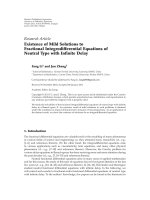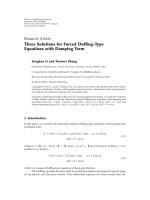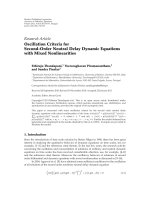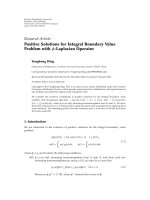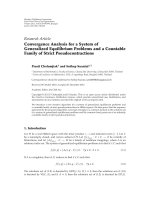Báo cáo hóa học: " Research Article Oscillation Criteria for Second-Order Neutral Delay Dynamic Equations with Mixed " pptx
Bạn đang xem bản rút gọn của tài liệu. Xem và tải ngay bản đầy đủ của tài liệu tại đây (523.9 KB, 14 trang )
Hindawi Publishing Corporation
Advances in Difference Equations
Volume 2011, Article ID 513757, 14 pages
doi:10.1155/2011/513757
Research Article
Oscillation Criteria for
Second-Order Neutral Delay Dynamic Equations
with Mixed Nonlinearities
Ethiraju Thandapani,
1
Veeraraghavan Piramanantham,
2
and Sandra Pinelas
3
1
Ramanujan Institute for Advanced Study in Mathematics, University of Madras, Chennai 600 005, India
2
Department of Mathematics, Bharathidasan University, Tiruchirappalli 620 024, India
3
Departamento de Matem
´
atica, Universidade dos Ac¸ores, 9501-801 Ponta Delgada, Azores, Portugal
Correspondence should be addressed to Sandra Pinelas,
Received 20 September 2010; Revised 30 November 2010; Accepted 23 January 2011
Academic Editor: Istvan Gyori
Copyright q 2011 Ethiraju Thandapani et al. This is an open access article distributed under
the Creative Commons Attribution License, which permits unrestricted use, distribution, and
reproduction in any medium, provided the original work is properly cited.
This paper is concerned with some oscillation criteria for the second order neutral delay
dynamic equations with mixed nonlinearities of the form rtut
Δ
qt|xτt|
α−1
xτt
n
i1
q
i
t|xτ
i
t|
α
i
−1
xτ
i
t 0, where t ∈ T and ut|xtptxδt
Δ
|
α−1
xt
ptxδt
Δ
with α
1
>α
2
> ···>α
m
>α>α
m1
> ···>α
n
> 0. Further the results obtained here
generalize and complement to the results obtained by Han et al. 2010 . Examples are provided to
illustrate the results.
1. Introduction
Since the introduction of time scale calculus by Stefan Hilger in 1988, there has been great
interest in studying the qualitative behavior of dynamic equations on time scales, see, for
example, 1–3 and the references cited therein. In the last few years, the research activity
concerning the oscillation and nonoscillation of solutions of ordinary and neutral dynamic
equations on time scales has been received considerable attention, see, for example, 4–8
and the references cited therein. Moreover the oscillatory behavior of solutions of second
order differential and dynamic equations with mixed nonlinearities is discussed in 9–16.
In 2004, Agarwal et al. 5 have obtained some sufficient conditions for the oscillation
of all solutions of the second order nonlinear neutral delay dynamic equation
r
t
y
t
p
t
y
t − τ
Δ
γ
Δ
f
t, y
t − δ
0 1.1
2 Advances in Difference Equations
on time scale T, where t ∈ T, γ is a quotient of odd positive integers such that γ ≥ 1, rt,
pt are real valued rd-continuous functions defined on T such that rt > 0, 0 ≤ pt < 1, and
ft, u ≥ qt|u|
γ
.
In 2009, Tripathy 17 has considered the nonlinear neutral dynamic equation of the
form
r
t
y
t
p
t
y
t − τ
Δ
γ
Δ
q
t
y
t − δ
γ
sgn y
t − δ
0,t∈ T, 1.2
where γ>0 is a quotient of odd positive integers, rt, qt are positive real valued rd-
continuous functions on T, pt is a nonnegative real valued rd-continuous function on T
and established sufficient conditions for the oscillation of all solutions of 1.2 using Ricatti
transformation.
Saker et al. 18,S¸ah
´
ıner 19, and Wu et al. 20 established various oscillation results
for the second order neutral delay dynamic equations of the form
r
t
y
t
p
t
y
τ
t
Δ
γ
Δ
f
t, y
δ
t
0,t∈ T, 1.3
where 0 ≤ pt < 1, γ ≥ 1 is a quotient of odd positive integers, rt, pt are real valued
nonnegative rd-continuous functions on T such that rt > 0, and ft, u ≥ qt|u|
γ
.
In 2010, Sun et al. 21 are concerned with oscillation behavior of the second order
quasilinear neutral delay dynamic equations of the form
r
t
z
Δ
t
γ
Δ
q
1
t
x
α
τ
1
t
q
2
t
x
β
τ
2
t
0,t∈ T, 1.4
where ztxtptxτ
0
t,γ, α, β are quotients of odd positive integers such that 0 <α<
γ<βand γ ≥ 1, rt, pt, q
1
t,andq
2
t are real valued rd-continuous functions on T.
Very recently, Han et al. 22 have established some oscillation criteria for quasilinear
neutral delay dynamic equation
r
t
x
Δ
t
γ−1
x
Δ
Δ
q
1
t
y
δ
1
t
α−1
y
δ
1
t
q
2
t
y
δ
2
t
β−1
y
δ
2
t
0,t∈ T,
1.5
where xtytptyτt, α, β, γ are quotients of odd positive integers such that 0 <α<
γ<β, rt, pt, q
1
t,andq
2
t are real valued rd-continuous functions on T.
Motivated by the above observation, in this paper we consider the following second
order neutral delay dynamic equation with mixed nonlinearities of the form:
r
t
u
t
Δ
q
t
|
x
τ
t
|
α−1
x
τ
t
n
i1
q
i
t
|
x
τ
i
t
|
α
i
−1
x
τ
i
t
0, 1.6
where T is a time scale, t ∈ T and ut|xtptxδt
Δ
|
α−1
xtptxδt
Δ
,and
this includes all the equations 1.1–1.5 as special cases.
Advances in Difference Equations 3
By a proper solution of 1.6 on t
0
, ∞
T
we mean a function xt ∈ C
1
rd
t
0
, ∞, which
has a property that rtxtptxτt
α
∈ C
1
rd
t
0
, ∞, and satisfies 1.6 on t
x
, ∞
T
.
For the existence and uniqueness of solutions of the equations of the form 1.6, refer to
the monograph 2. As usual, we define a proper solution of 1.6 which is said to be
oscillatory if it is neither eventually positive nor eventually negative. Otherwise it is known
as nonoscillatory.
Throughout the paper, we assume the following conditions:
C
1
the functions δ, τ, τ
i
: T → T are nondecreasing right-dense continuous and satisfy
δt ≤ t, τt ≤ t, τ
i
t ≤ t with lim
t →∞
δt∞, lim
t →∞
τt∞, and lim
t →∞
τ
i
t
∞ for i 1, 2, ,n;
C
2
pt is a nonnegative real valued rd-continuous function on T such that 0 ≤ pt < 1;
C
3
rt,qt and q
i
t, i 1, 2, ,nare positive real valued rd-continuous functions on
T with r
Δ
t ≥ 0;
C
4
α, α
i
, i 1, 2, ,nare positive constants such that α
1
>α
2
> ···>α
m
>α>α
m1
>
···>α
n
> 0 n>m≥ 1.
We consider the two possibilities
∞
t
0
1
r
1/α
s
Δs ∞,
1.7
∞
t
0
1
r
1/α
s
Δs<∞.
1.8
Since we are interested in t he oscillatory behavior of the solutions of 1.6, we may
assume that the time scale T is not bounded above, that is, we take it as t
0
, ∞
T
{t ≥ t
0
: t ∈
T}.
The paper is organized as follows. In Section 2, we present some oscillation criteria
for 1.6 using the averaging technique and the generalized Riccati transformation, and in
Section 3, we provide some examples to illustrate the results.
2. Oscillation Results
We use the following notations throughout this paper without further mention:
d
t
max
{
0,d
t
}
,d
−
t
max
{
0, −d
t
}
Q
t
q
t
1 − p
τ
t
α
,Q
i
t
q
i
t
1 − p
τ
i
t
α
i
,i 1, 2, 3, ,n,
κ
t
σ
t
t
,β
t
τ
t
σ
t
,β
i
t
τ
i
t
σ
t
,z
t
x
t
p
t
x
δ
t
.
2.1
In this section, we obtain some oscillation criteria for 1.6 using the following lemmas.
Lemma 2.1 is an extension of Lemma 1 of 13.
4 Advances in Difference Equations
Lemma 2.1. Let α
i
, i 1, 2, ,nbe positive constants satisfying
α
1
>α
2
> ···>α
m
>α>α
m1
> ···>α
n
> 0. 2.2
Then there is an n-tuple η
1
,η
2
, ,η
n
satisfying
n
i1
α
i
η
i
α 2.3
which also satisfies either
n
i1
η
i
< 1, 0 <η
i
< 1, 2.4
or
n
i1
η
i
1, 0 <η
i
< 1. 2.5
In the following results we use the Keller’s Chain rule 1 given by
y
α
t
Δ
αy
Δ
t
1
0
hy
σ
t
1 − h
y
t
α−1
dh, 2.6
where y is a positive and delta differentiable function on T.
Lemma 2.2 see 23. Let fuBu −Au
α1/α
,whereA>0 and B are constants, γ is a positive
integer. Then f attains its maximum value on R at u∗ B
γ
/A
γ1
γ
, and
max
u∈R
f f
u∗
γ
γ
γ 1
γ1
B
γ1
A
γ
. 2.7
Lemma 2.3. Assume that 1.7 holds. If xt is an eventually positive solution of 1.6, then there
exists a T ∈ t
0
, ∞
T
such that zt > 0, z
Δ
t > 0, and rtz
Δ
t
α
Δ
< 0 for t ∈ T,∞
T
.
Moreover one obtains
x
t
≥
1 − p
t
z
t
,t≥ t
1
. 2.8
Since the proof of Lemma 2.3 is similar to that of Lemma 2.1 in 6, we omit the details.
Lemma 2.4. Assume that 1.7 and
∞
t
0
τ
α
s
Q
s
Δs ∞ 2.9
Advances in Difference Equations 5
hold. If xt is an eventually positive solution of 1.6,then
z
ΔΔ
t
< 0,z
t
≥ tz
Δ
t
, 2.10
and zt/t is strictly decreasing.
Proof. From Lemma 2.3, we have rtz
Δ
t
α
Δ
< 0and
r
t
z
Δ
t
α
Δ
r
Δ
t
z
Δ
t
α
r
σ
t
z
Δ
t
α
Δ
. 2.11
Since r
Δ
t ≥ 0, we have z
Δ
t
α
Δ
< 0. Now using the Keller’s Chain rule, we find that
0 <
z
Δ
t
α
Δ
αz
ΔΔ
t
1
0
hz
Δ
t
1 − h
z
Δ
t
α−1
dh 2.12
or z
ΔΔ
t < 0. Let Zt : zt −tz
Δ
t. Clearly Z
Δ
t−σtz
ΔΔ
t > 0. We claim that there is
a t
1
∈ t
0
, ∞
T
such that Zt > 0ont
1
, ∞
T
. Assume the contrary, then Zt < 0ont
1
, ∞
T
.
Therefore,
z
t
t
Δ
tz
Δ
t
− z
t
tσ
t
−
Z
t
tσ
t
> 0,t∈
t
1
, ∞
T
, 2.13
which implies that zt/t is strictly increasing on t
1
, ∞
T
.Pickt
2
∈ t
1
, ∞
T
so that τt ≥ τt
2
and τ
i
t ≥ τ
i
t
2
for t ≥ t
2
. Then zτt/τt ≥ zτt
2
/τt
2
: d>0, and zτt/τt ≥
zτt
2
/τt
2
: d
i
> 0, so that zτt >τt for t ≥ t
2
.
Using the inequality 2.8 in 1.6, we have that
r
t
z
Δ
t
α
Δ
Q
t
z
α
τ
t
n
i1
Q
i
t
z
α
i
τ
i
t
≤ 0. 2.14
Now by integrating from t
2
to t, we have
r
t
z
Δ
t
α
− r
t
2
z
Δ
t
2
α
t
t
2
Q
s
z
α
τ
s
n
i1
Q
i
s
z
α
i
τ
i
s
Δs ≤ 0, 2.15
which implies that
r
t
2
z
Δ
t
2
≥ r
t
z
Δ
t
t
t
2
Q
s
z
α
τ
s
n
i1
Q
i
s
z
α
i
τ
i
s
Δs
>d
α
t
t
2
Q
s
τ
α
s
Δs
n
i1
d
α
i
i
t
t
2
Q
i
s
τ
α
i
i
s
Δs
2.16
6 Advances in Difference Equations
which contradicts 2.4. Hence there is a t
1
∈ t
0
, ∞
T
such that Zt > 0ont
1
, ∞
T
.
Consequently,
z
t
t
Δ
tz
Δ
t
− z
t
tσ
t
−
Z
t
tσ
t
< 0,t∈
t
1
, ∞
T
, 2.17
and we have that zt/t is strictly decreasing on t
1
, ∞
T
.
Theorem 2.5. Assume that condition 1.7 holds. Let η
1
,η
2
, ,η
n
be n-tuple satisfying 2.3 of
Lemma 2.1. Furthermore one assumes that there exist positive delta differentiable function ρt and a
nonnegative delta differentiable function φt such that
lim sup
t →∞
t
t
1
ρ
σ
s
⎡
⎣
Q
∗
s
− φ
Δ
s
−
ρ
Δ
s
ρ
σ
s
φ
s
−
κ
α
2
s
α 1
α1
r
s
ρ
Δ
s
α1
ρ
σ
s
α1
⎤
⎦
Δs ∞,
2.18
for all sufficiently large t
1
where Q
∗
tQtβ
α
tη
n
i1
Q
η
i
i
tβ
α
i
η
i
i
t, and η
n
i1
η
−η
i
i
.Then
every solution of 1.6 is oscillatory.
Proof. Suppose that there is a nonoscillatory solution xt of 1.6. We assume that xt is an
eventually positive for t ≥ t
0
since the proof for the case xt < 0 eventually is similar.From
the definition of zt and Lemma 2.3, there exists t
1
≥ t
0
such that, for t ≥ t
1
,
z
t
> 0,z
δ
t
> 0,z
τ
t
> 0,z
τ
i
t
> 0,z
Δ
t
> 0,
r
t
z
Δ
t
α
Δ
≤ 0.
2.19
Define
w
t
ρ
t
r
t
z
Δ
t
α
z
α
t
φ
t
,t≥ t
1
. 2.20
Then from 2.19, we have wt > 0and
w
Δ
t
ρ
Δ
t
ρ
t
w
t
ρ
σ
t
r
t
z
Δ
t
α
z
α
t
Δ
ρ
σ
t
φ
Δ
t
≤
ρ
Δ
t
ρ
t
w
t
ρ
σ
t
r
t
z
Δ
t
α
Δ
z
α
σ
t
− ρ
σ
t
r
t
z
Δ
t
α
z
α
t
Δ
z
α
t
z
α
σ
t
ρ
σ
t
φ
Δ
t
.
2.21
Advances in Difference Equations 7
From Keller’s chain rule, we have, from Lemma 2.1,
z
α
t
Δ
≥
⎧
⎨
⎩
αz
α−1
t
z
Δ
t
,α≥ 1,
αz
α−1
σ
t
z
Δ
t
, 0 <α<1.
2.22
Using 2.22 and the definition of κt in 2.21,weobtain
w
Δ
t
≤−
ρ
σ
t
z
α
σ
t
Q
t
z
α
τ
t
n
i1
Q
i
t
z
α
i
τ
i
t
ρ
Δ
t
ρ
t
w
t
−
αρ
σ
t
r
1/α
t
1
κ
α
t
w
t
ρ
t
− φ
t
α1/α
ρ
σ
t
φ
Δ
t
.
2.23
From Lemma 2.4,weseethatzt/t is strictly decreasing on t
1
, ∞
T
, and therefore
z
τ
i
t
τ
i
t
≥
z
σ
t
σ
t
2.24
or
z
τ
i
t
z
σ
t
≥
τ
i
t
σ
t
, 2.25
since τ
i
t ≤ σt for all i 1, 2, ,n.Using2.25 in 2.23, we have
w
Δ
t
≤−ρ
σ
t
Q
t
β
α
t
n
i1
Q
i
t
β
α
i
i
t
z
α
i
−α
σ
t
ρ
Δ
t
ρ
t
w
t
−
αρ
σ
t
r
1/α
t
1
κ
α
t
w
t
ρ
t
− φ
t
α1/α
ρ
σ
t
φ
Δ
t
.
2.26
Now let u
i
t1/η
i
Q
i
tβ
α
i
i
z
α
i
−α
σt,i 1, 2, ,n. Then 2.26 becomes
w
Δ
t
≤−ρ
σ
t
Q
t
β
α
t
n
i1
η
i
u
i
t
ρ
Δ
t
ρ
t
w
t
−
αρ
σ
t
r
1/α
t
1
κ
α
t
w
t
ρ
t
− φ
t
α1/α
ρ
σ
t
φ
Δ
t
.
2.27
8 Advances in Difference Equations
By Lemma 2.1 and using the arithmetic-geometric inequality
n
i1
η
i
u
i
≥
n
i1
η
u
i
i
in 2.27,we
obtain
w
Δ
t
≤−ρ
σ
t
Q
∗
t
− φ
Δ
t
ρ
Δ
t
ρ
t
w
t
−
αρ
σ
t
r
1/α
t
1
κ
α
t
w
t
ρ
t
− φ
t
α1/α
ρ
σ
t
φ
Δ
t
2.28
or
w
Δ
t
≤−ρ
σ
t
Q
∗
t
− φ
Δ
t
ρ
Δ
t
φ
t
ρ
Δ
t
w
t
ρ
t
− φ
t
−
αρ
σ
t
r
1/α
t
1
κ
α
t
w
t
ρ
t
− φ
t
α1/α
,t≥ t
1
.
2.29
Set γ α, A αρσt/r1/αt1/κ
α
t, B ρ
Δ
t
,andut
|wt/ρt − φt| and applying Lemma 2.2 to 2.29, we have
w
Δ
t
≤−ρ
σ
t
Q
∗
t
− φ
Δ
t
ρ
Δ
t
φ
t
1
α 1
α1
r
t
ρ
Δ
t
α1
ρ
σ
t
α
κ
α
2
t
.
2.30
Now integrating 2.30 from t
1
to t,weobtain
t
t
1
ρ
σ
s
⎡
⎣
Q
∗
s
− φ
Δ
s
−
ρ
Δ
s
ρ
σ
s
φ
s
−
1
α 1
α1
r
s
ρ
Δ
s
α1
ρ
σ
s
α1
κ
α
2
s
⎤
⎦
Δs ≤ w
t
1
,
2.31
which leads to a contradiction to condition 2.18. The proof is now complete.
By different choices of ρt and φt, we obtain some sufficient conditions for the
solutions of 1.6 to be oscillatory. For instance, ρt1, φt1andρtt, φt1/t
in Theorem 2.5, we obtain the following corollaries:
Corollary 2.6. Assume that 1.7 holds. Furthermore assume that, for all sufficiently large T,for
T ≥ t
0
,
lim sup
t →∞
∞
T
Q
∗
s
Δs ∞, 2.32
where Q
∗
t is as in Theorem 2.5. Then every solution of 1.6 is oscillatory.
Advances in Difference Equations 9
Corollary 2.7. Assume that 1.7 holds. Furthermore assume that, for all sufficiently large T,for
T ≥ t
0
,
lim sup
t →∞
∞
T
σ
s
Q
∗
s
−
r
t
σ
t
α
2
−α
t
α
2
Δs ∞, 2.33
where Q
∗
t is as in Theorem 2.5. Then every solution of 1.6 is oscillatory.
Next we establish some Philos-type oscillation criteria for 1.6.
Theorem 2.8. Assume that 1.7 holds. Suppose that there exists a function H ∈ C
rd
D, R,where
D ≡{t, s/t, s ∈ t
0
, ∞
T
and t>s} such that
H
t, t
0,t≥ t
0
,H
t, s
≥ 0,t>s≥ 0, 2.34
and H has a nonpositive continuous Δ-partial derivative H
Δ
s
with respect to the second variable such
that
H
Δ
s
σ
t
,s
H
σ
t
,σ
s
ρ
Δ
s
ρ
s
h
t, s
ρ
s
H
σ
t
,σ
s
α/α1
, 2.35
and for all sufficiently large T,
lim sup
t →∞
1
H
σ
t
,T
t
T
ρ
σ
s
Q
∗
s
−
h
t, s
α1
r
s
α 1
α1
ρ
σ
s
α
Δs ∞, 2.36
where Q
∗
t is same as in Theorem 2.5. Then every solution of 1.6 is oscillatory.
Proof. We proceed as in the proof of Theorem 2.5 and define wt by 2.20. Then wt > 0
and satisfies 2.28 for all t ∈ t
1
, ∞
T
. Multiplying 2.28 by Hσt,σs and integrating,
we obtain
t
t
1
H
σ
t
,σ
s
ρ
σ
s
Q
∗
s
− φ
Δ
t
Δs
≤−
t
t
1
H
σ
t
,σ
s
w
Δ
s
Δs
t
t
1
H
σ
t
,σ
s
ρ
Δ
t
ρ
s
w
t
Δs
−
t
t
1
H
σ
t
,σ
s
αρ
σ
t
r
1/α
t
ρ
α1/α
t
1
κ
α
t
w
t
ρ
t
− φ
t
α1/α
Δs.
2.37
10 Advances in Difference Equations
Using the integration by parts formula, we have
t
t
1
H
σ
t
,σ
s
w
Δ
s
Δs Ht, sws |
t
t
1
−
t
t
1
H
Δ
s
σ
t
,s
w
s
Δs
−H
t, t
1
w
t
1
−
t
t
1
H
Δ
s
σ
t
,s
w
s
Δs.
2.38
Substituting 2.38 into 2.37,weobtain
t
t
1
H
σ
t
,σ
s
ρ
σ
s
Q
∗
s
− φ
Δ
t
Δs
≤ H
t, t
1
w
t
1
t
t
1
H
Δ
s
σ
t
,s
H
σ
t
,σ
s
ρ
Δ
t
ρ
s
w
s
Δs
−
t
t
1
H
σ
t
,σ
s
αρ
σ
t
r
1/α
t
ρ
α1/α
t
1
κ
α
t
w
t
ρ
t
− φ
t
α1/α
Δs.
2.39
From 2.35 and 2.39, we have
t
t
1
H
σ
t
,σ
s
ρ
σ
s
Q
t, s
Δs
≤ H
t, t
1
w
t
1
t
t
1
h
t, s
ρ
s
H
α/α1
σ
t
,σ
s
w
s
Δs
−
t
t
1
H
σ
t
,σ
s
αρ
σ
t
r
1/α
t
ρ
α1/α
t
1
κ
α
t
w
t
ρ
t
− φ
t
α1/α
Δs
2.40
or
t
t
1
H
σ
t
,σ
s
Q
t, s
Δs
≤ H
t, t
1
w
t
1
t
t
1
h
t, s
ρ
s
H
α1/α
σ
t
,σ
s
w
s
ρ
s
− φ
s
Δs
−
t
t
1
H
σ
t
,σ
s
αρ
σ
t
r
1/α
t
ρ
α1/α
t
1
κ
α
t
w
t
ρ
t
− φ
t
α1/α
Δs.
2.41
where Qt, sρ
σ
sQt, s − ht, s/ρsH
1/α
σt,σsφs.
Advances in Difference Equations 11
By setting B ht, s/ρ s H
α1/α
σt,σs and A αρσt/r
1/α
tρ
α1/α
t 1/
κ
α
t in Lemma 2.2,weobtain
t
t
1
H
σ
t
,σ
s
ρ
σ
s
Q
t, s
−
h
α1
t, s
r
s
κ
α
2
t
α 1
α1
ρ
α
σ
s
H
σ
t
,σ
s
Δs
≤ H
t, t
1
w
t
1
,
2.42
which contradicts condition 2.35. This completes the proof.
Finally in this section we establish some oscillation criteria for 1.6 when the condition
1.8 holds.
Theorem 2.9. Assume that 1.8 holds and lim
t →∞
ptp<1.Letη
1
,η
2
, ,η
n
be n-tuple
satisfying 2.3 of Lemma 2.1. Moreover assume that there exist positive delta differentiable functions
ρt and θt such that θ
Δ
t ≥ 0 and a nonnegative function φt with condition 2.30 for all t ≥ t
1
.
If
∞
t
0
1
θ
s
r
s
s
t
0
θ
σ
v
Q
v
Δv
1/α
Δs ∞, 2.43
where
QtQt
n
i1
Q
i
t holds, then every solution of 1.6 either oscillates or converges to
zero as t →∞.
Proof. Assume to the contrary that there is a nonoscillatory solution xt such that xt > 0,
xδt > 0, xτt > 0, and xτ
i
t > 0fort ∈ t
1
, ∞
T
for some t
1
≥ t
0
.FromLemma 2.3 we
can easily see that either z
Δ
t > 0 eventually or z
Δ
t < 0 eventually.
If z
Δ
t > 0 eventually, then the proof is the same as in Theorem 2.5, and therefore we
consider the case z
Δ
t < 0.
If z
Δ
t < 0forsufficiently large t, it follows that the limit of zt exists, say a. Clearly
a ≥ 0. We claim that a 0. Otherwise, there exists M>0 such that z
α
τt ≥ M and
z
α
i
τ
i
t ≥ M, i 1, 2, ,n, t ∈ t
1
, ∞
T
.From1.6 we have
r
t
z
Δ
t
α
Δ
≤−M
Q
t
n
i1
Q
i
t
−M
Q
t
. 2.44
Define the supportive function
u
t
θ
t
r
t
z
Δ
t
α
,t∈
t
1
, ∞
T
, 2.45
12 Advances in Difference Equations
and we have
u
Δ
t
θ
Δ
t
r
t
z
Δ
t
α
θ
σ
t
r
t
z
Δ
t
α
Δ
≤ θ
σ
t
r
t
z
Δ
t
α
Δ
−Mθ
σ
t
Q
t
.
2.46
Now if we integrate the last inequality from t
1
to t,weobtain
u
t
≤ u
t
1
− M
t
t
1
θ
σ
s
Q
s
Δs 2.47
or
z
Δ
t
α
≤−M
1
θ
t
r
t
t
t
1
θ
σ
s
Q
s
Δs. 2.48
Once again integrate from t
1
to t to obtain
M
1/α
t
t
1
1
θ
s
r
s
s
t
1
θ
σ
ξ
Q
ξ
Δξ
1/α
Δs ≤ z
t
1
, 2.49
which contradicts condition 2.43. Therefore lim
t →∞
zt0, and there exists a positive
constant c such that zt ≤ c and xt ≤ zt ≤ c. Since xt is bounded, lim sup
t →∞
xtx
1
and lim inf
t →∞
xtx
2
. Clearly x
2
≤ x
1
. From the definition of zt,wefindthatx
1
px
2
≤
0 ≤ x
2
px
1
; hence x
1
≤ x
2
and x
1
x
2
0. This completes proof of the theorem.
Remark 2.10. If q
i
t ≡ 0, i 1, 2, ,n,orδtt − δ, τtt − τ,andq
i
t ≡ 0, i 1, 2, ,n,
then Theorem 2.5 reduces to a result obtained in 20 or 24, respecively. If pt ≡ 0, or pt ≡
0, and α 1, or pt ≡ 0, and τtτ
i
tt, i 1, 2, ,n, then the results established here
complement to the results of 5, 9, 15 respectively.
3. Examples
In this section, we illustrate the obtained results with the following examples.
Example 3.1. Consider the second order delay dynamic equation
x
t
1
t
2
x
δ
t
ΔΔ
λ
1
t
3/2
x
√
t
λ
2
t
x
5/3
√
t
λ
3
t
2
x
1/3
√
t
0, 3.1
Advances in Difference Equations 13
for all t ∈ 1, ∞
T
.Hereα 1, α
1
1/3, α
2
5/3, pt1/t
2
, qtλ
1
/t
3/2
, q
1
tλ
2
/t,and
q
2
tλ
3
/t
2
. Then η
1
η
2
1/2. By taking ρtt,andφt0, we obtain
lim sup
t →∞
t
t
1
ρ
σ
s
⎡
⎣
Q
∗
s
−
1
α 1
α1
r
s
ρ
Δ
s
α1
ρ
σ
s
α1
⎤
⎦
Δs
lim sup
t →∞
t
t
0
λ
1
s
1 −
1
s
λ
2
λ
3
s
1 −
1
s
−
1
4σ
s
Δs
≥ lim sup
t →∞
t
t
0
λ
1
λ
2
λ
3
−
1
4
1
s
−
λ
1
λ
2
λ
3
s
2
Δs
→∞if λ
1
λ
2
λ
3
> 1/4.
3.2
By Theorem 2.5, all solutions of 3.1 are oscillatory if λ
1
λ
2
λ
3
> 1/4.
Example 3.2. Consider the second order neutral delay dynamic equation
⎛
⎝
x
t
1
2
x
δ
t
Δ
3
⎞
⎠
Δ
σ
3
t
t
4
x
3
t
2
σ
t
t
2
x
5
t
3
σ
t
t
2
x
1/3
t
3
0, 3.3
for all t ∈ 1, ∞
T
.Herert1, pt1/2, qtσ
3
t/t
4
, τtt/2, τ
1
tτ
2
tt/3,
α 3, α
1
5, α
2
1/3. From Corollary 2.6, every solution of 3.3 is oscillatory.
Acknowledgment
The authors thank the referees for their constructive suggestions and corrections which
improved the content of the paper.
References
1 M. Bohner and A. Peterson, Dynamic Equations on Time Scales: An Introduction with Applications,
Birkh
¨
auser, Boston, Mass, USA, 2001.
2 M. Bohner and A. Peterson, Eds., Advances in Dynamic Equations on Time Scales,Birkh
¨
auser Boston
Inc., Boston, Mass, USA, 2003.
3 S. Hilger, “Analysis on measure chains—a unified approach to continuous and discrete calculus,”
Results in Mathematics, vol. 18, no. 1-2, pp. 18–56, 1990.
4 R. Agarwal, M. Bohner, D. O’Regan, and A. Peterson, “Dynamic equations on time scales: a survey,”
Journal of Computational and Applied Mathematics, vol. 141, no. 1-2, pp. 1–26, 2002.
5 R. P. Agarwal, D. O’Regan, and S. H. Saker, “Oscillation criteria for second-order nonlinear neutral
delay dynamic equations,” Journal of Mathematical Analysis and Applications, vol. 300, no. 1, pp. 203–
217, 2004.
6 L. Erbe, A. Peterson, and S. H. Saker, “Oscillation criteria for second-order nonlinear delay dynamic
equations,” Journal of Mathematical Analysis and Applications, vol. 333, no. 1, pp. 505–522, 2007.
7 S. H. Saker, D. O’Regan, and R. P. Agarwal, “Oscillation theorems for second-order nonlinear neutral
delay dynamic equations on time scales,” Acta Mathematica Sinica, vol. 24, no. 9, pp. 1409–1432, 2008.
14 Advances in Difference Equations
8 J. Shao and F. Meng, “Oscillation theorems for second-order forced neutral nonlinear differential
equations with delayed argument,” International Journal of Differential Equations, vol. 2010, Article ID
181784, 15 pages, 2010.
9 R. P. Agarwal, D. R. Anderson, and A. Zafer, “Interval oscillation criteria for second-order forced
delay dynamic equations with mixed nonlinearities,” Computers & Mathematics with Applications, vol.
59, no. 2, pp. 977–993, 2010.
10 R. P. Agarwal and A. Zafer, “Oscillation criteria for second-order forced dynamic equations with
mixed nonlinearities,” Advances in Difference Equations, vol. 2009, Article ID 938706, 20 pages, 2009.
11 C. Li and S. Chen, “Oscillation of second-order functional differential equations with mixed
nonlinearities and oscillatory potentials,” Applied Mathematics and Computation, vol. 210, no. 2, pp.
504–507, 2009.
12 S. Murugadass, E. Thandapani, and S. Pinelas, “Oscillation criteria for forced second-order mixed
type quasilinear delay differential equations,” Electronic Journal of Differential Equations, p. No. 73, 9,
2010.
13 Y. G. Sun and F. W. Meng, “Oscillation of second-order delay differential equations with mixed
nonlinearities,” Applied Mathematics and Computation, vol. 207, no. 1, pp. 135–139, 2009.
14 Y. G. Sun and J. S. W. Wong, “Oscillation criteria for second order forced ordinary differential
equations with mixed nonlinearities,” Journal of Mathematical Analysis and Applications, vol. 334, no.
1, pp. 549–560, 2007.
15 M.
¨
Unal and A. Zafer, “Oscillation of second-order mixed-nonlinear delay dynamic equations,”
Advances in Difference Equations, vol. 2010, Article ID 389109, 21 pages, 2010.
16 Z. Zheng, X. Wang, and H. Han, “Oscillation criteria for forced second order differential equations
with mixed nonlinearities,” Applied Mathematics Letters, vol. 22, no. 7, pp. 1096–1101, 2009.
17 A. K. Tripathy, “Some oscillation results for second order nonlinear dynamic equations of neutral
type,” Nonlinear Analysis: Theory, Methods & Applications, vol. 71, no. 12, pp. e1727–e1735, 2009.
18 S. H. Saker, R. P. Agarwal, and D. O’Regan, “Oscillation results for second-order nonlinear neutral
delay dynamic equations on time scales,”
Applicable Analysis, vol. 86, no. 1, pp. 1–17, 2007.
19 Y. S¸ah
´
ıner, “Oscillation of second-order neutral delay and mixed-type dynamic equations on time
scales,” Advances in Difference Equations, vol. 2006, Article ID 65626, 9 pages, 2006.
20 H W. Wu, R K. Zhuang, and R. M. Mathsen, “Oscillation criteria for second-order nonlinear neutral
variable delay dynamic equations,” Applied Mathematics and Computation, vol. 178, no. 2, pp. 321–331,
2006.
21 Y. Sun, Z. Han, T. Li, and G. Zhang, “Oscillation criteria for second-order quasilinear neutral delay
dynamic equations on time scales,” Advances in Difference Equations, vol. 2010, Article ID 512437, 14
pages, 2010.
22 Z. Han, S. Sun, T. Li, and C. Zhang, “Oscillatory behavior of quasilinear neutral delay dynamic
equations on time scales,” Advances in Difference Equations, vol. 2010, Article ID 450264, 24 pages,
2010.
23 G. H. Hardy, J. E. Littlewood, and G. P
´
olya, Inequalities, Cambridge University Press, Cambridge, UK,
2nd edition, 1952.
24 S. H. Saker, “Oscillation of second-order nonlinear neutral delay dynamic equations on time scales,”
Journal of Computational and Applied Mathematics, vol. 187, no. 2, pp. 123–141, 2006.
